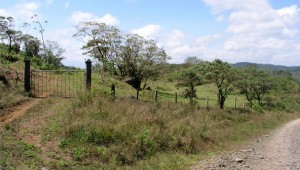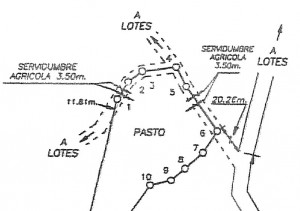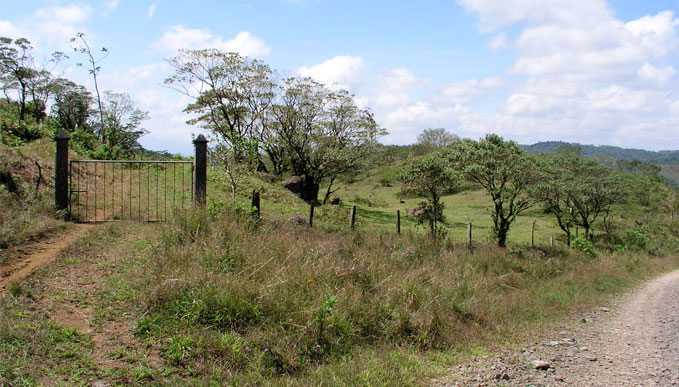The fact that you are reading this article means you are interested in purchasing or selling a piece of Costa Rica real estate.
For buyers, let me first lead you through a visualization to help attract the perfect property… You drive up a well-maintained gravel road and turn onto a large, flat building area… A cool ocean breeze is blowing as you step out of the car… the 180 degree view stretches from emerald mountains to a wide and tranquil blue horizon. After days (dare I say years) of searching, you’ve finally found it!

The next step is getting into the details. The property boundaries are clearly defined for you using the registered survey (el plano catastrado). Upon closer inspection, you see a squiggly line labeled servidumbre is running inside the boundary. What is that squiggly line, and is it even important?
In Costa Rica, a servidumbre refers to an easement. It provides a legal right for the owner or owners of a property touched by the easement. Without getting too technical, the “dominant” property is encumbered and the “servant” property is improved by the easement. Even if the dominant property is subdivided and sold to new owners, the new properties created will carry the legal title of the servidumbre.
There are instances when an easement is not labeled on the plano, but (if done correctly) they are registered as a “lien” on the title.
Types of Servidumbres
Servidumbres provide value for property in the ever-growing and changing landscape of Costa Rican real estate. They come in a variety of distinctions and protect a variety of interests—
- Access to a property, often through another property (Servidumbre de Paso)
- Water, the right to use a water source and/or maintain water lines (Servidumbre del Acueducto)
- Environmental, like extracting road material like rock/stone (Servidumbres de extracción de materials)
- The View, often important with ocean view property (Servidumbre de Vista)
Protecting “The View”
View easements have played a part in a few deals in the past. Our friend Eduardo Abarca Vargas, who happens to be an excellent lawyer in Uvita, helped me understand the details of this important property detail.
There are a couple of ways to legally describe view easements. The first is a description based on the numbered boundary points on the plano . (see illustration) The description (always in Spanish) could read ¨the easement will affect the area of the property within the boundary point 1 and 3 of the property.¨
The second method is when a certified survey crew uses GPS coordinates (lat./long. and elevation). Based on that data, the maximum height of buildings, trees, towers, etc. on the property below are stated in meters. Eduardo explains, “One of the most important items is to state the direction the view will be protected, for instance, the easement will protect the view towards the ocean.”

These Legal Teeth Are Sharp
That’s one of the best things about servidumbres; they have legal significance that cannot be separated from the estate or piece of land to which they are registered. We know of a few cases where a property owner has tried to prevent access along a servidumbre de paso by putting up a gate. Thanks to the easement, a judge ordered him to take it down under the supervision of the police. Legal costs aside, there is no cost to having a servidumbre other than paying for any work associated with enjoying the easement (e.g., road or water system maintenance).
Normally, easements are granted into perpetuity and remain unchanged when the property is transferred to new buyers. There are only a few ways an easement can be dissolved:
- The owner of the dominant estate acquires ownership of the servant estate or vice versa.
- Waiver from the dominant estate holder, although such waivers have to be reviewed by a judge.
- No use. Typically, it takes between 10 and 20 consecutive years of non-use to dissolve an easement.
New servidumbres can be registered, but they require the written agreement of all of the owners of a property. This can be challenging when dealing with a large family farm, but not impossible.
Due Diligence
As I mentioned, easements can be found on the registered property survey and in the title, recorded as a “lien”. They are discovered during the due diligence phase of buying your property. Click here to read more on the stages of buying Costa Rica real estate.
I may sound like a broken record, but I can’t stress the importance of a good lawyer enough. If you want to ensure your dream property doesn’t have any “surprises” get a good one with years of experience with property transactions. Our legal associate Eduardo has uncovered many interesting easement issues for our clients over the past four+ years. Feel free to contact him directly at: edabarca@racsa.co.cr or (011) 506-2743-8345.
It wasn’t the most entertaining subject to write about, but it’s an important one to consider before buying a piece of Costa Rica real estate.

great real estate…
http://www.casasprefabricadascostarica.com/precios/
are business owners allowed to put up advertisement signs on a servidumbre or easment